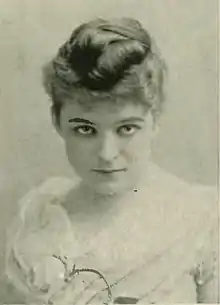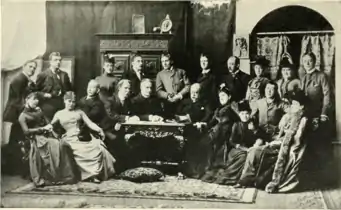Emma Sheridan Fry
Emma Sheridan Fry (pen name, Polly and E. V. Sheridan; October 1, 1864 – 1936) was an American actor, playwright, and teacher. She started her career as a stage actress and after retiring from that, she became a writer for various periodicals and wrote plays. In 1903, she established the Children's and Young People's Theatre in New York City.[1] Also in that city, she served as director of the Children's Educational Theatre and the Educational Players, as well as teaching at the American Academy of Dramatic Arts.
Emma V. Sheridan Fry | |
|---|---|
 "A woman of the century" | |
| Born | Emma Viola Sheridan October 1, 1864 Painesville, Ohio, U.S. |
| Died | 1936 Westwood, New Jersey, U.S. |
| Pen name | Polly, E. V. Sheridan |
| Occupation | journalist |
| Language | English |
| Nationality | American |
| Alma mater | New York Lyceum School of Acting, American Academy Dramatic Arts |
| Subject | drama |
| Notable works | Educational dramatics |
| Spouse | |
| Children | Sheridan Brooks Fry |
| Relatives | George Augustus Sheridan (father) |
Early years and education
Emma Viola Sheridan was born in Painesville, Ohio, October 1, 1864. Her mother, Emma Christina (Huther) Sheridan,[2] was a niece of the New England clergyman, Rev. Joseph W. Parker. Her father, Congressman George Augustus Sheridan,[3] fought with the Army of the Cumberland during the American Civil War, and later developed a national reputation as an orator. Fry was always his friend, confidant and counselor.[4]
She was a graduate of Mrs. Hay's preparatory academy, Boston, Massachusetts, and of the Normal College in New York City (now, Hunter College). Choosing the stage as the field of her work, she went through a thorough course of study and training in the New York Lyceum School of Acting (now, Lyceum Theatre).[4] She graduated from the American Academy Dramatic Arts, 1885.[2]
Career

Fry began at the bottom and in six seasons, she rose to the front rank among American actors, filling many important roles. In 1887, she played a notable engagement with Richard Mansfield in the Lyceum Theatre, London, England. Returning to the United States, she played a round of leading Shakespearean parts with Thomas Keene. In 1889, she became the leading lady in the Boston Museum Company.[2] At the close of her second and most successful season there, her stage career was cut short by her marriage.[4]
During her stage experience, Sheridan was also a writer of general syndicate newspaper work, writing many articles, stories and verses published in the daily press, in magazines and in dramatic papers over her signature. She was well known as "Polly" in the New York Dramatic Mirror, writing the Polly Papers. She also wrote a "Wednesday Afternoon" column for the Boston Commonwealth, which included theater reviews and dramatic commentary.[5] After her retirement from the stage, Sheridan, for she retained her signature, "E. V. Sheridan", devoted all her time to writing, and she was in this second profession rapidly repeating the progress and notable success of her stage career.[4]

On February 23, 1892, Mansfield produced at the Garden Theatre, New York, a play by Sheridan entitled, £10,000 a Year, founded on Dr. Samuel Warren's hook of the same name, Ten Thousand a-Year, and it won a flattering success. [4] She prepared a text book of Educational Dramatics, and Educational Players' Students Arrangement ofTwelfth Night and Macbeth.[2]
Founded by Alice Minnie Herts, and with Mark Twain as president of the board, Fry became the director of the Children's Educational Theatre, New York City,[6][7] in 1904, and conducted all of its educational work till January 1, 1909. She took charge, as dramatic director, of the Educational Players, New York City, in 1910. She was also a teacher at the American Academy of Dramatic Arts, 1909-10. At the Children's Educational Tbeatre, she produced The Prince and the Pauper, written by her from Mark Twain's book; the Abby Sage Richardson play, produced with the Educational Players, 1910; Midsummer Night's Dream at the Morris High School, New York; and produced The Tempest for Smith College alumnae, 1898.[2]
Fry was a member of the New England Woman's Press Association,[8] and the Pen and Brush Club, New York City. She served as president of the Alumni Association of the Lyceum School of Acting.[4]
Personal life
In 1891, in Deer Isle, Maine, she married Alfred Brooks Fry,[2] Chief Engineer of the United States Treasury service, a member of the Loyal Legion, and of the Order of the Cincinnati by heredity.[4] They had son, Sheridan Brooks Fry,[2] who was born in 1893.[9] Fry favored woman suffrage. By religion, she was Episcopalian.[2] She died in 1936,[10] in Westwood, New Jersey.[11]
Selected works
- Educational dramatics : a handbook on the educational player method, 1917
References
- Ohles, Ohles & Ramsay 1997, pp. 119-20.
- Leonard 1914, p. 309.
- "Fry – Sheridan" (PDF). New York Times. July 31, 1890. Retrieved 2015-03-02.
- Willard & Livermore 1893, p. 305.
- Fisher & Londré 2017, p. 602.
- Beatrice L. Tukesbury, "Emma Sheridan Fry and Educational Dramatics" Educational Theatre Journal 16(4)(December 1964): 341-348.
- "Thirty-Five Actors Resign" New York Sun (February 11, 1909): 7. via Newspapers.com

- New England Woman's Press Association 1895, p. 12.
- "Alfred Brooks Fry". New York Red Book. 1909.
- García-Romero 2016, pp. 33, 45, 46, 192, 230.
- Ohles, Ohles & Ramsay 1997, p. 119.
Attribution
 This article incorporates text from a publication now in the public domain: Leonard, John William (1914). Woman's Who's who of America: A Biographical Dictionary of Contemporary Women of the United States and Canada, 1914-1915 (Public domain ed.). American Commonwealth Company. p. 309.CS1 maint: ref=harv (link)
This article incorporates text from a publication now in the public domain: Leonard, John William (1914). Woman's Who's who of America: A Biographical Dictionary of Contemporary Women of the United States and Canada, 1914-1915 (Public domain ed.). American Commonwealth Company. p. 309.CS1 maint: ref=harv (link)  This article incorporates text from a publication now in the public domain: New England Woman's Press Association (1895). New England Woman's Press Association: Organized Nov. 17, 1885 : Chartered Sept. 15, 1890 (Public domain ed.). Somerville Journal Printers.CS1 maint: ref=harv (link)
This article incorporates text from a publication now in the public domain: New England Woman's Press Association (1895). New England Woman's Press Association: Organized Nov. 17, 1885 : Chartered Sept. 15, 1890 (Public domain ed.). Somerville Journal Printers.CS1 maint: ref=harv (link)  This article incorporates text from a publication now in the public domain: Willard, Frances Elizabeth; Livermore, Mary Ashton Rice (1893). A Woman of the Century: Fourteen Hundred-seventy Biographical Sketches Accompanied by Portraits of Leading American Women in All Walks of Life (Public domain ed.). Moulton. p. 305.CS1 maint: ref=harv (link)
This article incorporates text from a publication now in the public domain: Willard, Frances Elizabeth; Livermore, Mary Ashton Rice (1893). A Woman of the Century: Fourteen Hundred-seventy Biographical Sketches Accompanied by Portraits of Leading American Women in All Walks of Life (Public domain ed.). Moulton. p. 305.CS1 maint: ref=harv (link)
Bibliography
- Fisher, James; Londré, Felicia Hardison (22 November 2017). Historical Dictionary of American Theater: Modernism. Rowman & Littlefield Publishers. ISBN 978-1-5381-0786-7.CS1 maint: ref=harv (link)
- García-Romero, Anne (24 March 2016). The Fornes Frame: Contemporary Latina Playwrights and the Legacy of Maria Irene Fornes. University of Arizona Press. ISBN 978-0-8165-3144-8.CS1 maint: ref=harv (link)
- Ohles, Frederik; Ohles, Shirley M.; Ramsay, John G. (1997). Biographical Dictionary of Modern American Educators. Greenwood Publishing Group. p. 119. ISBN 978-0-313-29133-3.CS1 maint: ref=harv (link)